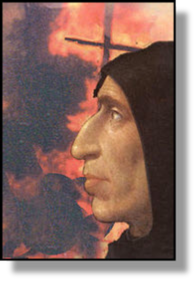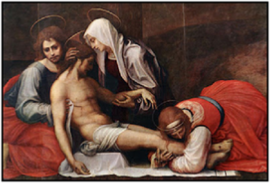


GIROLAMO SAVONAROLA 1452 -
(H6, E4, E5, R3, H7)
 xxxxxThe Italian religious reformer Girolama Savonarola was born at Ferrara of a noble family. He began his ecclesiastical life as a Dominican friar, and early in his career taught at the priory of San Marco in Florence. It was here that, as an eloquent and powerful preacher, he began his moral crusade, calling for a return to the basic Christian virtues and bitterly attacking religious as well as political corruption. Returning to Florence in 1490 after a short time preaching in northern Italy -
xxxxxThe Italian religious reformer Girolama Savonarola was born at Ferrara of a noble family. He began his ecclesiastical life as a Dominican friar, and early in his career taught at the priory of San Marco in Florence. It was here that, as an eloquent and powerful preacher, he began his moral crusade, calling for a return to the basic Christian virtues and bitterly attacking religious as well as political corruption. Returning to Florence in 1490 after a short time preaching in northern Italy -
xxxxxWhen the French invaded the city in 1494 and the Medicis were expelled -
xxxxxThis leader, at the time, was the Borgia Pope Alexander VI, who earlier, in 1493, had applauded Savonarola’s zealous programme of reform and, indeed, had named him the papacy’s first vicar general. He now became much alarmed at the turn of events. He forbade him to preach until an enquiry had been held. An uneasy truce followed, but Savonarola soon returned to the attack, and in 1497 he was excommunicated, an act he simply chose to ignore.
xxxxxBy now, however, his stringent political reforms within the city of Florence, aimed at the repression of vice, were proving increasingly unpopular, and a party of the Medici family (known as the Arrabbiati, “the angry ones”) was gaining support. Then when Savonarola executed five of the Arrabbiati as “conspirators” the populace turned against him. In 1498 he was arrested, tortured, and, after being tried for sedition and “religious errors”, was hanged and burned. A stone plaque in the Piazza della Signoria marks the exact spot where he was executed -
xxxxxSavonarola’s dedication to his cause, though downright fanatical, is to be admired at a time when such outspoken criticism would clearly not be tolerated. He was virtually born to be a martyr. Educated by his paternal grandfather, a man of high religious principles, he had spoken in his youth of “the blind wickedness of the peoples of Italy”. Throughout his life of devotion, this attack upon the sins of society and the corruption and abuses within the church and state never faltered. A man devoted to the study of scripture -
xxxxxThe Italian religious reformer Girolama Savonarola called for a return to the basic Christian virtues and attacked religious and political corruption. When the French invaded Florence in 1494 and expelled the Medici, he seized power and held sway over the city, introducing strict moral reforms. In 1497, however, he was excommunicated and, when he executed five members of the Medici family the populace turned against him. In 1498 he was arrested and executed. A devout, albeit fanatical Christian, he was greatly influenced by the works of the Italian theologian Thomas Aquinas. His major work Triumphus crucis was a clear exposition of the Christian faith.
Including:
Fra Bartolommeo

xxxxxLike Sandro Botticelli, (1478 E4), the Florentine artist Fra Bartolommeo was seriously affected by the preaching and execution of Savonarola. In 1500 he destroyed all his drawings and paintings of the nude figure and joined the Dominican Order. Confining his work to religious subjects, his style was influenced by Raphael and Michelangelo, and he began to use the richer colours of the Venetian school. Among his finest paintings were two deeply moving works, his Madonna of Mercy and his Pietà.
xxxxxLike  Sandro Botticelli, whose work, as we have seen earlier (1478 E4), was seriously affected by the preaching and execution of Savonarola, the Florentine artist Baccio della Porta (1472-
Sandro Botticelli, whose work, as we have seen earlier (1478 E4), was seriously affected by the preaching and execution of Savonarola, the Florentine artist Baccio della Porta (1472-
xxxxxAs a young man he served in the workshop of Cosimo Rosselli -
xxxxxAmong his major accomplishments are a monumental altarpiece, Eternal Father with Mary Magdelene and Saint Catherine of Siena, the Mystic Marriage of Saint Catherine, and his Pietà (illustrated above), one of his most powerful works. Shown below are: The Apparition of the Virgin to St. Bernard, St. Catherine of Siena, and The Virgin admiring the Child with Saint Joseph.




Acknowledgements
Bartolommeo: portrait of Savonarola – San Marco Museum, Florence; Pietà -
H7-